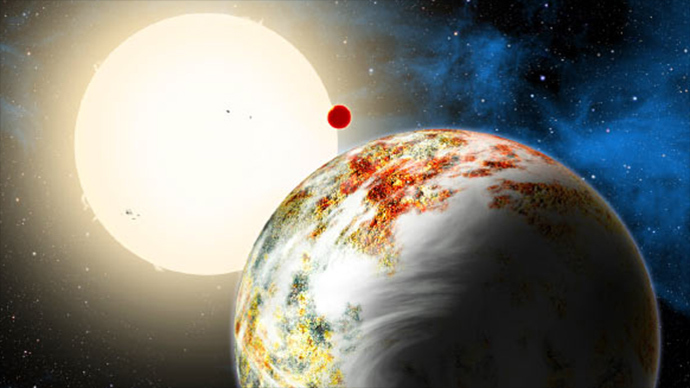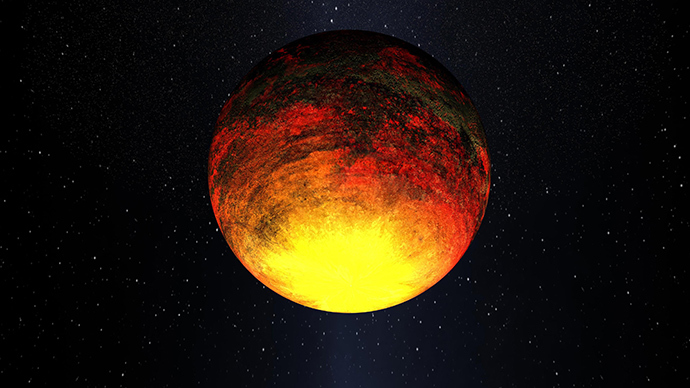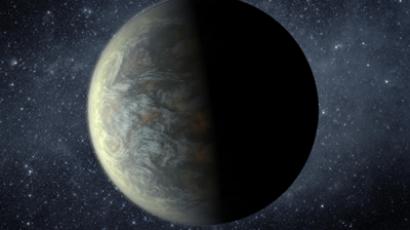'The Godzilla of Earths!' New planet weighing 17 times greater than Earth discovered

A humungous Earth-like planet found by US astronomers has changed the perception of planet formation. A rocky world found by Kepler space observatory should by rights have become a giant ball of gas, but has remained a planet for billions of years.
The newly discovered Kepler-10c planet has been dubbed ‘Mega-Earth’ thanks to its diameter of 29,000 kilometers and an estimated weight 17 times greater than Earth, which has a diameter of 12,742 kilometers. This makes Kepler-10c the biggest rocky planet ever discovered.
The new planet is circling a very old Sun-like star, Kepler-10, some 560 light years from Earth. If you look up in the sky this star can be seen in the Draco constellation, which is 300 million light years away.

The Kepler-10c planet is so unique because scientists hitherto believed that planets so big could only be made mostly of gas, like our solar system’s Jupiter and Saturn, which have a solid core of rock and metals, surrounded by a deep layer of frozen and liquid hydrogen, helium and other gases.
"A mega-Earth is a lot of solids concentrated in the same place without any gas. That is a problem because our understanding for how planets form requires the solids to get together in an environment where almost 99 percent of the mass ... is hydrogen and helium," Dimitar Sasselov, professor of astronomy at Harvard University and director of the Harvard Origins of Life Initiative, told reporters. Sasselov described the newly-found planet as “the Godzilla of Earths.”
“This is a planet that doesn't fit the usual models of planetary formation,” the Guardian reported Xavier Dumusque, of the Harvard Smithsonian Centre for Astrophysics, as saying. The staggering mass of Kepler-10c was measured by the Italian National Galileo Telescope on Las Palmas in the Canary Islands, Dumusque said. The average weight of Kepler-10c matter is 7 grams per cubic centimeter, which suggests the alien world is made mostly of rock.
The Kepler space observatory first spotted Kepler-10c in 2011, but at the time it could only guess at the approximate size of the planet: about 30,000 kilometers in diameter. Later the solar system was subjected to a closer inspection.
The discovery of an unusual planet was announced at the American Astronomical Society meeting in Boston. Speaking to reporters after the meeting, Sasselov said that the discovery of a mega-Earth planet increases the chances of finding extraterrestrial life forms.
“As far as we know – and we know very little about origins of life – we think that life emerged from geochemistry” and such processes more easily occur on solid planets, Sasselov said, adding that it takes more time to form a large solid planet and in the process such planets could gather up large amounts of gas.
“Finding Kepler-10c tells us that rocky planets could form much earlier than we thought. And if you can make rocks, you can make life,” Sasselov said.
So far Kepler-10c’s surface is estimated to be as hot as 310 degrees Celsius, but if it has an atmosphere, than it means its surface could be cool enough to host life.
The Kepler-10 solar system was formed about 11 billion years ago, or a mere 3 billion years after the Big Bang. For reference, our own solar system was formed 4.6 billion years ago.
The system also has another planet, a lava world Kepler-10b that closely orbits its sun every 20 hours. A year on Kepler-10c lasts 45 Earth days.

A discovery of a solid rock mega-planet is a great event for astronomers as the absolute majority, or 75 percent, of the planets discovered by Kepler space observatory are gas giants with diameters less than four times of that of Earth’s.














